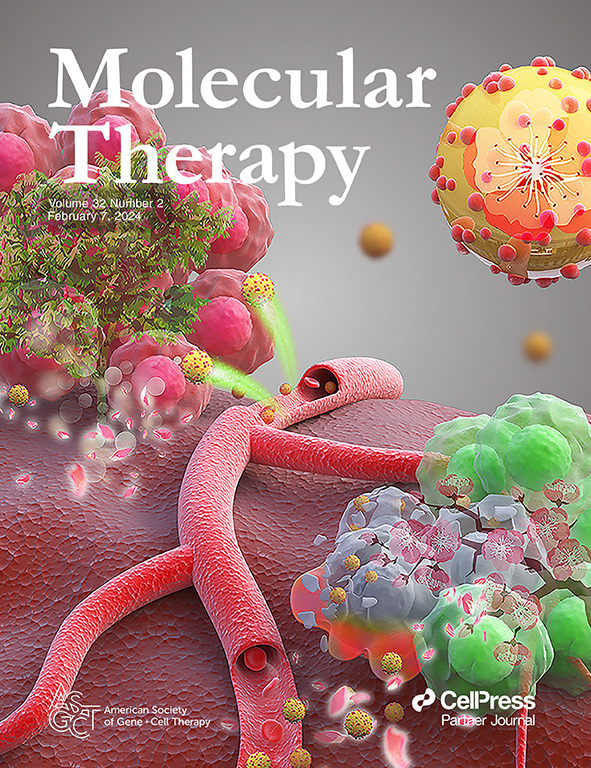aav递送的microRNA基因治疗1型肌强直性营养不良的进展。
IF 12
1区 医学
Q1 BIOTECHNOLOGY & APPLIED MICROBIOLOGY
引用次数: 0
摘要
肌强直性营养不良1型(DM1)是成人肌营养不良最常见的形式,其特征是危及生命的肌肉无力,呼吸受损,常伴有心脏传导异常。DM1是由营养不良肌强直蛋白激酶(DMPK)基因的3'非翻译区CTG重复扩增引起的,导致DMPK mRNA聚集成不溶性的核糖核灶,隔离rna结合蛋白。必要剪接因子的重新分配导致负责肌肉分化的因子的错误剪接。通过减少DMPK RNA靶向疾病的根源有望减少RNA的病灶和发病机制。在这里,我们提出了一种基于AAV- rnai的DMPK减少策略,该策略基于肌肉靶向平台,该平台包括具有高肌肉转导效率的AAV衣壳,在肌肉中具有强活性的启动子和靶向DMPK的人工miRNA。在DM1的细胞和动物模型中,我们发现AAV递送靶向DMPK的人工miRNA可降低DMPK RNA水平,并改善分子、病理和临床相关的疾病标志。在非人灵长类动物中,我们发现AAV-amiRDMPK/SAR446268治疗耐受性良好,并导致所有主要肌肉群中DMPK mRNA的剂量依赖性下调(高达90%)。总之,我们的数据为SAR446268的有效性和安全性提供了证据。本文章由计算机程序翻译,如有差异,请以英文原文为准。
Development of an AAV-delivered microRNA gene therapy for Myotonic Dystrophy Type 1.
Myotonic dystrophy type 1 (DM1), characterized by life-threatening muscle weakness, compromised respiration, and often cardiac conduction abnormalities, is the most common form of adult muscular dystrophy it is. DM1 is caused by a CTG repeat expansion in the 3' untranslated region of the dystrophia myotonica protein kinase (DMPK) gene resulting in aggregation of DMPK mRNA into insoluble ribonuclear foci which sequester RNA-binding proteins. Redistribution of essential splicing factors causes mis-splicing of factors responsible for muscle differentiation. Targeting the disease at its root by reducing DMPK RNA promises to reduce RNA foci and pathogenesis. Here, we present an AAV-RNAi based strategy for DMPK reduction based on a muscle-targeted platform comprising an AAV capsid with high muscle transduction efficiency, a promoter with strong activity in muscle, and a DMPK-targeting artificial miRNA. In cellular and animal models of DM1 we show that AAV delivery of an artificial miRNA targeting DMPK reduces DMPK RNA levels, and improves molecular, pathological, and clinically relevant disease hallmarks. In non-human primates, we show AAV-amiRDMPK/SAR446268 treatment is well tolerated and results in a dose-dependent downregulation of DMPK mRNA (up to 90%) in all major muscle groups. Together, our data provide evidence of the efficacy and safety of SAR446268.
求助全文
通过发布文献求助,成功后即可免费获取论文全文。
去求助
来源期刊

Molecular Therapy
医学-生物工程与应用微生物
CiteScore
19.20
自引率
3.20%
发文量
357
审稿时长
3 months
期刊介绍:
Molecular Therapy is the leading journal for research in gene transfer, vector development, stem cell manipulation, and therapeutic interventions. It covers a broad spectrum of topics including genetic and acquired disease correction, vaccine development, pre-clinical validation, safety/efficacy studies, and clinical trials. With a focus on advancing genetics, medicine, and biotechnology, Molecular Therapy publishes peer-reviewed research, reviews, and commentaries to showcase the latest advancements in the field. With an impressive impact factor of 12.4 in 2022, it continues to attract top-tier contributions.
 求助内容:
求助内容: 应助结果提醒方式:
应助结果提醒方式:


